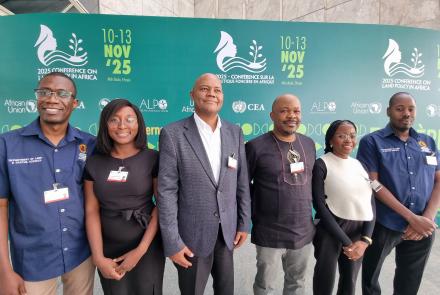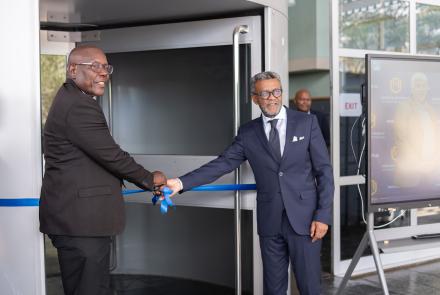Leading with Vision: Steering NUST Towards Innovation and Eminence
Since his appointment as the Namibia University of Science and Technology (NUST) Vice-Chancellor in 2021, Prof Erold Naomab has strengthened the University’s academic excellence, financial sustainability, and global engagement. Prof Naomab, who also serves as the Chairperson of the Board of the Association of African Universities for Southern Africa, is determined to ensure that NUST remains a leading institution in science, technology, and innovation.
Over the past five years, several innovative programmes have been introduced, while industry partnerships have been strengthened, further diversifying revenue streams.
Solidifying NUST’s Research Portfolio
A key focus has been the implementation of mechanisms to enhance NUST’s research portfolio. Since 2021, the University has established four UNESCO Chairs focused on Sustainable Water Research for Climate Adaptation and Saline Agriculture in Arid Environments; Gender and Digital Technologies; Secure High-Performance Computing for Higher Education and Research; and Digital Technology Design with Indigenous People.
A UNESCO Chair is awarded to a highly competitive research team or project at a university or higher education institution that partners with UNESCO to advance knowledge and practice in priority areas.
Since its establishment in 2021, the UNESCO Chair on Gender and Digital Technologies has produced over 30 research publications, supervised more than 20 postgraduate theses, and mobilised over US$300 000 in funding. Meanwhile, the UNESCO Chair in Digital Technology Design with Indigenous People, established in March 2024, has led the development of Namibia’s draft National Action Plan for the International Decade of Indigenous Languages and is spearheading an Indigenous People’s Knowledge Fair to strengthen knowledge governance and digital innovation — a testament to the broader value these Chairs bring to NUST’s research and innovation ecosystem.
Moreover, NUST continues to demonstrate transformative foresight by focusing on transitioning from a teaching-oriented university to a research-led, research-driven university. “This is illustrated by a threefold increase in research output since 2015. In addition, NUST produced more than 2 300 publications in high-end, reputable, peer-reviewed journals over the last five years. The success of NUST emerging as a world-class, research-driven university is further demonstrated by research funding surpassing N$1 billion over the last five years, coupled with the graduation of more than 4 000 postgraduate students, including Honours, Master’s, and PhD students,” Naomab said.
Alignment with National Development Priorities
NUST’s commitment to research-driven innovation is evident in impactful projects such as the Solar Energy Groundwater Pumping Technology initiative in Eenhana, which addresses water security through renewable energy solutions; the Mobile Skillshare Training Units in Gobabis, which extend vocational training to underserved rural communities; and the Digital Cultural Expedition and Tourism Community-Based Platform, aimed at boosting local tourism and community economic development.
Similarly, the NUST-SEED Living Lab in Groot Aub contributes to rural development and sustainability through off-grid renewable energy systems, smart metering, and local entrepreneurship support. These efforts, alongside consistently high graduate employability rates and active involvement in Namibia’s digital transformation—particularly in e-governance, artificial intelligence (AI), and smart technology adoption— underscore the University’s integral role in shaping the country’s future.
Expansion of the University’s National Footprint
The University has expanded its physical presence across Namibia, and is now operating four campuses – Windhoek, Lüderitz, Eenhana and Rietfontein – as well as 10 regional centres nationwide. The student population is expected to exceed 22 000 by the end of the year, with plans to open a new campus in Windhoek’s Kleine Kuppe suburb.
This new campus will allow NUST to better accommodate the needs of professionals and industry partners while expanding the Institution’s footprint in the capital. The Harold Pupkewitz Graduate School of Business (HP-GSB) is a key cornerstone in this expansion.
NUST has significantly broadened its reach throughout Namibia to improve access to higher education, particularly in remote areas and urban regions with limited educational opportunities.
Promoting Digital Transformation
Furthermore, through a partnership with MTC and Huawei under the Smart Campus Initiative, the University has focused on integrating Fourth Industrial Revolution (4IR) technologies into the curriculum, enhancing e-learning platforms, and fostering research in areas such as cybersecurity and cloud computing. These initiatives aim to equip students with the skills needed to thrive in a digitally driven world.
Under the University’s High-Tech Transfer Plaza Select (HTTPS), an ecosystem that is home to global tech giants such as the Huawei Academy, Samsung, and Bloomberg Finance Lab, NUST continues to make strides. “This is punctuated by the launch of groundbreaking initiatives such as Namibia’s first Science and Technology Park in Lüderitz, and Namibia’s first Artificial Intelligence and Robotics Accelerator laboratory, sponsored by the Bank of Namibia. Soon, the University’s Digital Arts and Animation Department will officially be launched,” Naomab added.
Looking Ahead
Marking a decade since its transformation from a polytechnic to a university, NUST continues to advance its mission through a strong emphasis on research, innovation, and entrepreneurship – anchored in growing postgraduate enrolment, strategic industry partnerships, and a focus on student success and well-being.
As the University’s 2021-2025 Strategic Plan comes to an end, NUST is forging ahead with the implementation of a new Integrated Strategic Business Plan for the year 2026 and beyond, which Prof Naomab is equally excited about.






